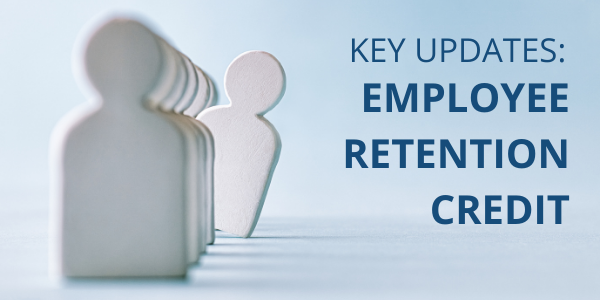
Breaking Down the Updates on the Employee Retention Credit
Before we get started on the details, as you may be aware, Section 2301 of the CARES Act allowed a credit against employment taxes (Employee Retention Credit or “ERC”) for qualified employers. Fortunately, this credit has been extended, the pool of eligible employers has been expanded, and its potential value elevated.
To help navigate the numerous updates, we have provided some of the more impactful highlights in a scannable Q&A format below. We have also included a list of helpful links to access additional information at the end of this article.
Which IRS notices provide the latest guidelines?
- IRS Notice 2021-20 provided initial guidance as to eligible tax payments from March 12, 2020, through December 31,2020. More recently, Section 207 of the Relief Act extended the eligibility period from January 1, 2021, through June 30, 2021, with guidance provided in IRS Notice 2020-23.
- Most recently, Section 9651 of the American Rescue Plan Act of 2021 (ARP Act) amended section 3134 of the Internal Revenue Code (Code) by extending the ERC to include wages remitted from July 1, 2021, through December 31, 2021, with specific guidance outlined in Notice 2021-49.
What is the value of the ERC credit?
For 2021, an employer can receive 70% (up from 50% in 2020) of wages in each quarter for which an employer is deemed qualified up to a maximum of $7,000 per employee per quarter or $28,000 per year per employee.
What is the credit for Small vs. Large Employers?
Small Employers now have the elevated threshold of 500 or fewer full-time employees (versus just 100 employees in 2020) significantly broadening the number of businesses who qualify. The advantage of Small Employer status is that small employers can include payments to any employee (active or inactive) with payments to qualified health plans also included in the calculation of wages.
Large Employers (see exception for severely financially distressed) receive no benefit from payments to active employees. They are limited to wages, including any payments to a qualified health plan, to employees who were retained but not actively providing services during the measurement period.
How does a company qualify as “Severely Financially Distressed”?
The definition of Large Employers who are “severely financial distressed” also changed. For 2021, 10% of year over year earnings as opposed to 80% under prior rules is now the standard. For those who quality, they can include all wage payments to employees whether they are actively providing services or not.
How can startups with less than $1 million in earnings be assisted?
Under the original financial tests, employers who began on or after February 15, 2020, were, by default, ineligible or unable to qualify for the ERC under the financial test (lost business) as they had no pre-2020 earnings to allow them to meet the lost earning test. They were thus limited to having been subjected to a government suspension. This has now changed.
For Q3 and Q4 of 2021, post February 14, 2020, startups with less than $1 million in earnings may qualify as a “recovery startup business” and be eligible for up to $50,000 in ERC for each of the last two quarters for 2021 using 2020
How does an entity qualify for the credit?
Two fundamental tests remain, with a slight adjustment for the earnings test in 2021 over 2020:
- An entity whose operations were fully or partially suspended due to a governmental order is eligible to claim ERC for the suspension period; or
- An entity whose gross receipts are less than 80% (up from 50% in 2020) of the same quarter in 2019.
Alternative Quarters Option
One little spin on option (2) of the financial test above is that in comparing 2021 and 2019 quarterly performance, the employer has the option of using the quarter immediately preceding the current quarter. For instance, an employer can use Q2 of 2019 and 2021 or Q1 to meet the gross receipts test for Q2 of 2021.
What about business suspension Test & Other Issues?
The IRS provides a rather robust FAQ guide that clarifies qualified wages, calculating the credit and what qualifies as having been fully or partially suspended due to a governmental order. The lay language does come with qualifications (refer to Section 3134 and referenced notices), but they are quite sound.
How does an employer claim the credit?
- Employers under 500 employees need only request an advance on the credit as an offset to payroll tax payments provided in conjunction with the Employer’s Quarterly Federal Tax Return (Form 941). See Form 7200 guidance below.
- Penalty relief is found within Notice 2021-24 which extends the provisions of Notice 2020-22 to apply to deposits of employment taxes reduced in anticipation of the employee retention credit under the Coronavirus Aid, Relief and Economic Security Act (Cares Act) and the ERC under IRC Section 3134.
What if a business is qualified but failed to file a claim for an ERC credit?
- No deadlines or statute of limitations have been provided thus far, but we suggest you file Form 941-X as quickly as possible.
Can an employer leverage both PPP & ERC?
- Previously, employers receiving a PPP loan during the first round of relief couldn’t take advantage of the ERC. However, with the new legislation, a business can take the ERC even if they received PPP funding and loan forgiveness as long as the payroll identified for the ERC was not paid out of PPP funds.
Need some guidance? We can help.
Harney Partners has a 30+ year history of serving companies as a financial advisor in a host of technical and operational areas. We specialize in restructuring and turnaround, bankruptcy advisory, fiduciary services, transaction advisory, interim management, and forensics and litigation services. Please contact us if we may be of assistance.

